Dear Azami, When I moved a few years ago, I lost my Commander group, so I turned to Magic Online for my Commander fix. Long story short, I now have a regular Commander group again and am looking to build some of the decks I enjoy playing online in paper. Unfortunately some cards *cough* Portal Three Kingdoms *cough* are a bit harder to find in paper than online. The following deck started off as a ten ticket challenge and is my take on a Mono-Green Ramp/Voltron deck with the goal of pumping up */* creatures such as Molimo, Maro-Sorcerer and Dungrove Elder by putting a bunch of lands on the table and relying less on pantsing them up. I’m trying to not do anything too abusive with the ramp; its primary purpose in the deck is to power up my beaters. To stay alive while trying to get in with a fatty, I have fairly expansive Fog suite, which works fairly well, but covering the battlefield in mist for the first several turns isn’t the most fun for my opponents. I’d like to cut back on the Fogs while still giving me room to get enough lands out to make my */* creatures threats. Without further preamble, here is the deck: Commander Creatures (22) Traproot Kami Artifacts (11) Relic of Progenitus Enchantments (7) Gaea’s Touch Instants (5) Hunter’s Insight Sorceries (11) Nature’s Lore Lands (43) Encroaching Wastes Overall, the deck works fairly well and can swing in for some pretty large (trampling) commander damage, with the fallback of just swinging in with large creatures. The deck doesn’t have much card draw, but there’s enough redundancy and thinning in the deck that I can usually topdeck into the cards I need. I’d like to try to add more enchantments or artifacts that go on the table and can buff my creatures, similar to how Broken Fall and Asceticism protect them. Ideally I’d like to cut all the pants from the deck to make it a Voltron deck that doesn’t have to equip or enchant its creatures directly. I don’t think there are enough cards in green that do this yet, so there’s some compromise. My biggest concern is mass land destruction even though it’s mostly frowned upon; however, it is the best answer for this deck. To try to address this, I have the Timber Protector and Treefolk Harbinger to keep my Forests alive in the face of Armageddon effects. Some recursion effects like Life from the Loam or Nostalgic Dreams may help, but I’m not sure that they would add much utility to the deck. Some cards I’ve been considering are Crop Rotation and Realms Uncharted to help find my utility lands more easily; however, I’m not sure if it’s really necessary. Likewise Sylvan Library and Abundance can help with the digging, but I’m concerned that will slow down my turn a bit too much. I’d like to stay away from the standard landfall cards like Avenger of Zendikar and Rampaging Baloths, as that seems like it’s straying too far from the Voltron feel the deck currently has. Something like Grazing Gladehart could be interesting though. Thanks for giving us an article every week, and thanks for taking a look at my deck and giving me some ideas for transitioning it to paper. Steven |
Looking at your overall strategy, the plan is to use green’s abundant access to ramp effects in order to provide an overall boost to the power and toughness of your creatures rather than solely to cast big spells (as is more typically why people cast Boundless Realms). That means you inherit the same tension that ramp decks run into where the balance of ramp versus “real” spells is a very delicate one that has to be carefully maintained, with the payoff in your case coming from the ability to attack for lethal with a powerful creature like Dungrove Elder or (more ideally) your commander.
This means we’re going to find an interesting tension in the early game, where half of our cards want us to put them into play immediately and the other half want us to play ramp effects and wait to deploy our threats—especially at the three-mana slot, where a fair chunk of your deck seems to sit.
I picked your deck because it’s an interesting take on mono-green, a refresher compared to the more typical Azusa, Lost but Seeking or Omnath, Locus of Mana decks that tend to hog this space. I also picked it to follow up on my last article because you’re crossing over from Magic Online to paper at the same time I am making a somewhat opposite transition. In building an actually affordable Commander deck for my enjoyment and edification, I realized I could also build it on Magic Online at an affordable price, so I was intrigued to see your take on Magic Online Commander now that I’m starting to give it a whirl.
I think we’ve even played—or at least I played against someone rocking Molimo who played a fair chunk of these cards—and thus I feel predisposed to give you the help since some of the switches I’m going to make are also thoughts I had during that game. Unfortunately the Magic Online interface doesn’t really allow for the personal interactions where you talk to people about your decks after you’ve played an interesting game.
It just so happens that I have a column for that and you submitted your deck to it, so of course I was going to pick it when given the chance!
So You Want To Build A Beatdown?
Building an aggressive deck in Commander is a difficult thing, and yours is inheriting all of an aggro deck’s weaknesses alongside a ramp deck’s complications and balance issues. We can totally work on this, but it isn’t going to come out perfect every time—that’s one of the ramp deck issues you just can’t fix. We’re playing a Highlander format, not something like Legacy where its built-in access to four copies of Brainstorm and a plethora of fetch lands means you can easily customize your hand and adjust the balance of which cards you’ve drawn over the course of a game.
Even if you had access to blue for its easy card draw, you’d still face that problem, so we begin with the forewarning that we aren’t going to be able to win all of the games all of the time. Ramp decks just sort of trip on themselves and do nothing some twenty percent or so of all games, and we’re going to aim to get us down to that lower boundary. But we have to accept that it’s a hard threshold; we can build your deck to be the best version of itself that it can be, but we can’t defy statistics past a reasonable point.
One of the best things we can do to straighten that out is to insist on a many-for-one exchange—or at least a card-neutral exchange—when trying to acquire resources. Putting a land into play with Rampant Growth is okay, but getting that same land drop ahead with Explore would be even better since you don’t really care where the land comes from—you’ll draw plenty of them regardless—and having the word “draw a card” attached to your ramp effect helps to ensure that you don’t draw all ramp and no business.
Ultimately, as much as I like Explore, I ended up cutting it in favor of more permanent effects. I love the card but could only fit so many slots with ramp cards, and the second rule is more important because Explore is a unique effect, with the next closest comparison being Solemn Simulacrum with its card draw upon death. The second rule is to simply have higher standards—all of our ramp cards have to pull at least two lands out of our deck, not one, so smaller effects like Sakura-Tribe Elder and Wood Elves just have to go in order for us to hit these higher standards.
This will help us cut back the overall number of ramp cards, leaving more room for business, which is also what you’re sensing with your thoughts that you have an overreliance on Equipment cards and buffs like Blanchwood Armor. There aren’t that many of the kinds of cards you want to build your deck around in your monocolored card pool, so we’re going to have to stretch that idea a little, but by honing in on what really matters we can increase the likelihood that your draws match your expectations, with everything balanced just right. Fewer ramp cards and fewer buff cards means you’ll draw more primary action cards, and streamlining all of these choices allows you to strengthen the deck overall.
The biggest drawback I see to building this deck on paper rather than on Magic Online is that two very pricey additions I’m going to suggest—nearly $100 in real cardboard value—would cost you about 25 tickets online instead. We’ll make up for this by preventing you from having to put down $30 on a Portal Three Kingdoms common, but it does mean right off the bat that there’s no way we’re staying in the $10 budget deck arena.
Our first change will be to the mana. We’re going to swap seven lands, cutting your Tectonic Edge and Encroaching Wastes alongside five Forests in order to add a little bit more utility and card advantage, some of which will be crucially relevant when we go to add a few other cards later on. They’re small changes that are basically cosmetic here but will have a considerable strategic import alongside specific cards we’re adding.
In:
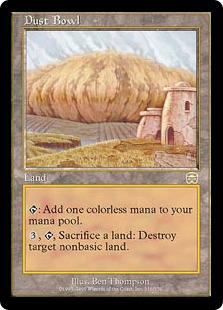
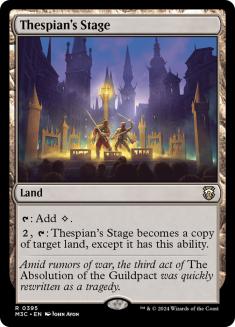
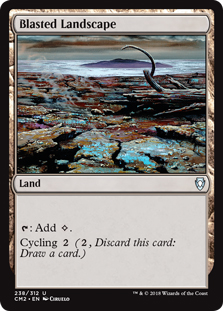
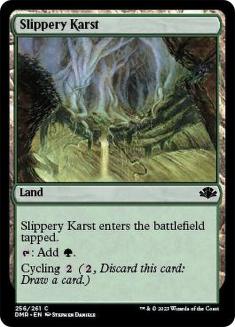
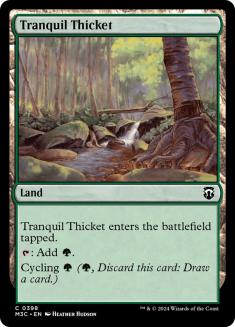
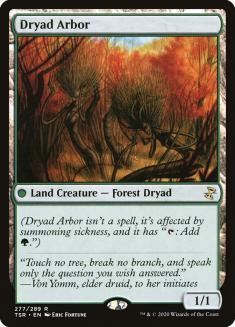
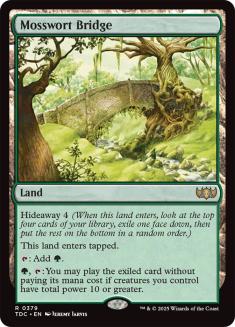
The cycling lands will help moderate your draws, and the difference between 37 Forests and 32 is pretty small over the course of 99 cards. Since you’re so land heavy, ideally we’re hoping in the stages of the game where flooding out is relevant (and deadly—players who lack relevance wind up dead) that you’ll draw a cycling land instead of a basic land and be one card closer to that crucial topdeck that will win you the game. They’ll also interact more powerfully with other stuff, as is also the case with that otherwise suspicious Dryad Arbor. Thespian’s Stage is going to either copy a powerful land on your opponent’s side of the board or duplicate one of your own and at the very worst can turn itself back into a basic Forest for your Forests matter cards to count as a +1.
Dust Bowl is simply a strict upgrade to Encroaching Wastes and gives you a solid way to handle someone who’s being abusive in their land base. You’re going to have a lot of ways to put extra lands to work if you want since they’re providing +1/+1 to your best guys, not actually necessary to cast your spells, so being able to recur the LD effect of Encroaching Wastes if you want to is a strong benefit to add. Our last addition is Mosswort Bridge—you’re already building your deck such that your commander by itself should be able to trigger the size requirements of green’s hideaway land, so being able to potentially get a free spell back out of a land is a serious benefit to add.
The Spell’s The Thing
We’re going to combine all the types of noncreature spells together into one big pile, reorganizing them so they’re in better overall alignment with your general plan and applying The Rule to your ramp spells—two lands or go home. This means we’re going to be a little harsh, especially to the “buffs” you didn’t think were really all pulling their weight, and give us the ability to work in some more card draw and a bit more board control. That’s a real weakness for the color, so we’re going to enjoy what parts of it we’re able to obtain at a reasonable price and run with it, using some actual pinpoint destruction to solve problems instead of rely on Fog effects—not because they’re unfun, but because I don’t think they’re actually all that effective.
I don’t see them being worth a card unless they stop more than one dangerous combat coming your way, and as solid as Tangle and Spore Cloud are for gumming up attackers, I just don’t see that as an effective way to stop two attacks. It’s an excellent way to punish your attacker, yes, but it does not actually have a second Fog effect stapled to the first the way a Constant Mists with buyback does.
Out:
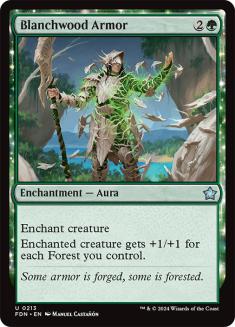
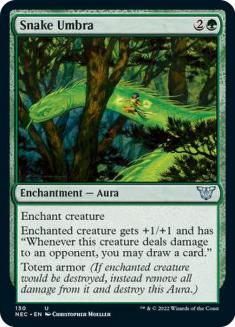
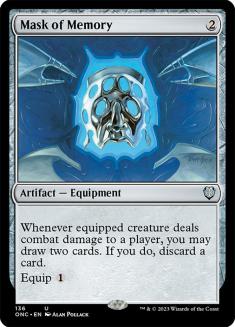
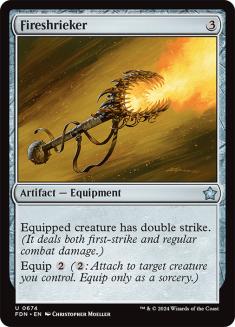
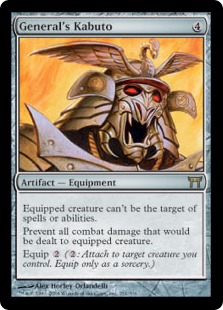
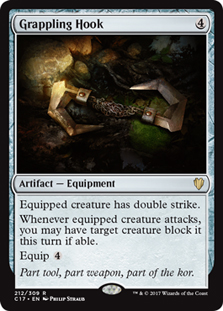
The four Equipment are getting cut because they don’t do quite enough—Strata Scythe is a big boost even if it is a ‘dumb’ one, while the Warhammer provides a huge life swing (and trample). I don’t see double strike as being that special, and have never yet seen a Grappling Hook kill off a relevant creature and affect a game as anything more than a backup Fireshrieker – just like I don’t see General’s Kabuto as much more than a third (worse) copy of Lightning Greaves / Swiftfoot Boots.
Blanchwood Armor’s the simplest version of the Big Dumb Buff, and Snake Umbra is only on theme for you because of the ability to potentially regenerate a key creature. Frankly we’ve already run through the good options; I don’t think we want to start committing to Totem Armors in order to try to keep the best creatures on your board safely in play. You’re already playing all of the reasonable regeneration effects, and I just don’t believe in Snake Umbra for its card draw. I’d rather play the Snake itself than its Umbra.
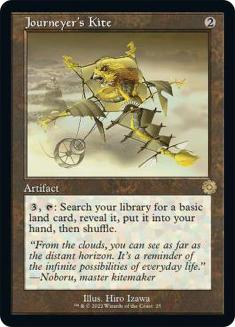
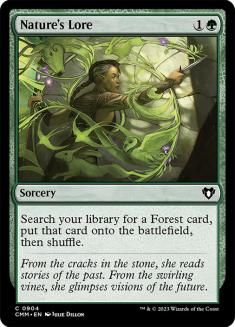
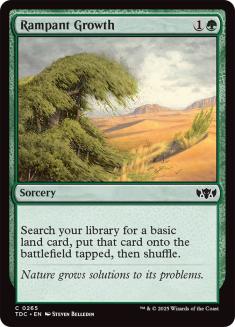
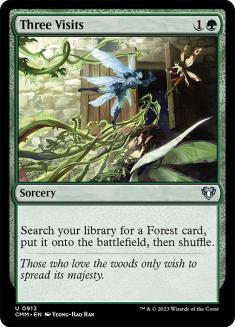
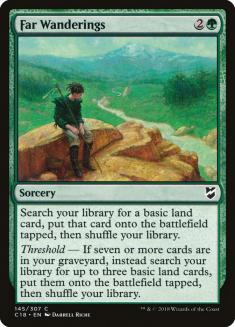
While the Kite will put multiple lands in your hand, we’re going to get that same effect for less mana out of other cards instead, so it’s less special than it otherwise would be as we streamline the deck. The other four are variations on the same problematic theme—pay a bit of mana, put one land from your deck into play. Yes, Far Wanderings could do more, but the likelihood of doing so on any relevant timescale is literally zero for this deck. By the time you have threshold, the specialness of the ramp effect has faded away already.
And that leaves just the “miscellaneous” cuts:
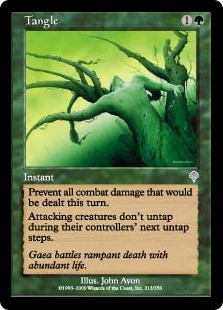
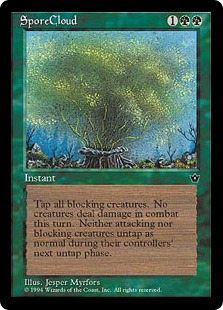
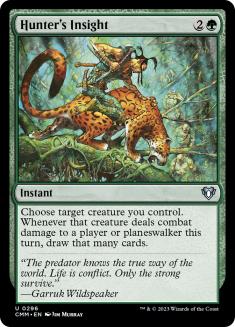
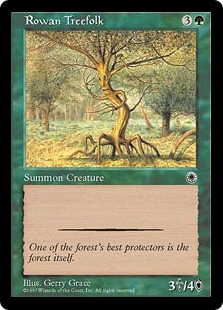
The two Fogs are getting cut for a direct upgrade and a pinpoint removal spell, which hopefully will help keep you aligned on the main plan of attacking for lethal. Mostly you don’t need a lot of this effect because you’re the beatdown and just one copy will keep surprises at bay and let you properly beat down on the real problems—if someone drops an Overrun effect you didn’t see coming, you want to be able to weather it and attack back, but a lot of Fog effects’ utility can be taken away by picking your targets for judicious beatdowns a bit more purposefully. I see these as a bit of a crutch and am happy to take that crutch away and let the deck’s beatdown plan stand more on its own.
Hunter’s Insight doesn’t strike me as the best possible version of this effect for this deck even though it is sweet to cast it on an unblocked Molimo and draw a pile of cards, while Rowan Treefolk takes such a long time to provide a bigger benefit than Harmonize that I’d rather stay with the straightforward effect and get the immediate benefit than plan to get extra benefit after Rowan’s stayed in play for the tenth draw step in a row. Permanents die, even enchantments, you can’t assume that just because it’s innocuous that it will sit in play long enough to pay you back for the investment you’ve made in it.
In:
Harmonize – We just “spoiled” that one, but it’s no-nonsense card draw and basically the only nonnegotiable draw spell you have access to in your color of choice. That it’s “only” Concentrate doesn’t matter because Concentrate is still pretty high on the list of playable draw spells when you’re not blue. Black has multiple playable copies of Concentrate with “pay three life” stapled to it, all of which I have seen put in people’s decks very effectively over the years, so that you get the three-word no-nonsense color-shifted Concentrate is actually really strong and should be automatically in your playables pile.
Hunter’s Prowess – Unlike Hunter’s Insight, this gives a power boost (and trample!) to potentially amplify this effect. Yes, it’s sorcery speed instead of instant speed, but as far as getting blown out by a removal spell is concerned, that’s not a relevant issue. Hunter’s Prowess doesn’t really care about blockers because it grants a buff and the necessary trample, so it doesn’t actually have to go on an unblocked creature to have its effect. Point it at your biggest guy and then point that guy at your weakest opponent—you won’t be disappointed.
Garruk, Primal Hunter – This is the “actual” version of this Hunter’s Prowess / Hunter’s Insight effect in that it doesn’t require targeting or going through the attack phase in order to draw you a chunk of cards. Yes, it may “feel bad” to bin your planeswalker as if it were “just” a Harmonize effect, but we’re including it because of that effect alone. The ability to grind out an advantage from repeatedly using Garruk’s +1 ability to put a 3/3 Beast into play is a bonus, not the plan.
Green Sun’s Zenith – This is able to serve as “best threat” or “ramp spell” thanks to our inclusion of Dryad Arbor, letting you hit your most important drop at each point on the curve or play as a Rampant Growth effect if what you need is another land, not another threat. It’s a rare card that lets you bridge that divide and is well worth playing a not very sturdy land in order to make it work in the first place, and a decent chunk of the time this is just going to be another utility guy like Acidic Slime or Indrik Stomphowler.
Those cards are very relevant to your interests, and this is another copy of those as needed that can also double up on Timber Protectors if you suspect a party-fouling Armageddon may be in your future or a Dawnstrider if people are going to let you abuse the Fog effects. You have just enough utility to make this worthwhile and at least one solid top-end fatty to hunt for when you’ve drawn more mana than you know what to do with.
Realms Uncharted – I’m less interested in this because it gets utility lands and more interested in it because it gets two lands instead of one. I have however managed to use other cards in order to let it bridge a divide, just like Green Sun’s Zenith. This can fetch you lands and thus work on the asset accumulation side of things, or it can fetch the awesome four-card pile of Blasted Landscape, Slippery Karst, Tranquil Thicket, and Mosswort Bridge and let it serve as card draw instead of ramp.
Hunting Wilds – You had three of the four possible copies of this effect, with Explosive Vegetation, Ranger’s Path, and Skyshroud Claim already in your deck. Hunting Wilds completes the set and is the often forgotten weird cousin because it lets you use additional mana to turn it into a threat card as well as a ramp card if that’s what your deck needs later in the game. I’ve personally never kicked it, at least not in Commander (I have played a lot of Draft after all), but the potential to do so lets it fill two sides of the deck instead of just the one and thus is the most “special” version of the effect for this deck to include.
Exploration – I originally wanted to add Burgeoning since I’ve had good results with it so far in my new “Hail To The Queen” five-color planeswalker control deck, but your results would probably not be quite as strong since my results are based on a deck with ten bounce lands to double up the specialness of this specific effect.
For your deck I think the ability to play an additional land a turn is more important—we’ve just added Green Sun’s Zenith to serve as a potential second copy of Oracle of Mul Daya and are sure to add the newest version of that effect as well while we’re at it when we get to the creature section, so being able to gain additional land drops has a meaningful effect in your deck, while Burgeoning’s advantage is purely the lower price tag that it enjoys in paper Magic. I think that benefit is large enough that I’m willing to bend my usual rules on the price of the cards we include in decks here on Dear Azami, as you want this exact specific version of the card rather than the next best effect.
Moment’s Peace – Rather than try to bootstrap a second Fog effect through keeping the offending attackers tapped, I’m going the simple route and adding the Fog effect that comes with a second Fog effect already stapled to it. This can bypass the problem we’d see with mass untap effects like Prophet of Kruphix and Seedborn Muse or the even simpler problem of “multiple people tried to kill me,” which is a pretty typical problem to have when you’re not interacting on the board and just jamming attacks at one another. It can still handle two attacks, but it does so more concretely instead of trying to get cute with it in a way your opponents can potentially work around.
Beast Within – If Desert Twister was good enough to run, getting it at half price and at instant speed has to be good enough too. Instead of another Fog effect to replace the one we’ve shaved, I’d rather play the catchall removal spell and just not worry over the fact that it puts a 3/3 Beast into play—your monsters are so much bigger than that that I can’t really see it as something that would provide a meaningful barrier or threatening attacker.
You’re so light on meaningful instants that it provides a real strategic benefit just by existing in your hand, allowing you to play the beatdown more effectively without worrying about what might come back your way, and I’m kind of surprised it didn’t make the cut in your initial build of the deck—or at least the more than 10 dollar build, as you were building on Magic Online and it tends to live somewhere around the average price of .30 or .40 tickets.
Night Soil – Part graveyard hate (and thus part board control to keep opponents who want to get out of hand from actually getting there) and part token generator. I found your foresight in adding Relic of Progenitus to your build to be very important and wanted to run it back and then faced the choice of this or Scavenging Ooze and selected the permanent type that is harder to remove from play, even if this is the more narrowly constrained card because of its restriction to just creatures and its awkward specificity that the two creatures must come from the same graveyard.
(Ground Seal could also have hit the spot, but I tend to worry more about Karador effects and less about targeted reanimation so I didn’t list it in the top tier—if your playgroup would find Ground Seal to be more impactful than Night Soil, by all means swap it out in favor of the cantrip.)
Beacon of Creation – This is another way to play up your Forests matter theme in the fatty department, and while it’s true that it doesn’t generate a single creature with that key */* size, it does generate the same amount of power as Uktabi Wildcats. A pile of token creatures can have a lot more utility in some situations and thus is not “just” a worse version of that effect . . .
Skullclamp – As the first of two Equipment we are going to add back into your deck can surely attest. Skullclamp is going in your deck for the power of the card draw even though you won’t end up keeping most of the one-toughness creatures you started with in your build. We’ve made up for that by balancing it out with a few token generation effects. You really need the card draw help, and this is both super powerful and budget conscious at the same time.
Druidic Satchel – This is my choice for replacing Rowan, as it has the same beneficial effect in the instances where the top of your deck is a land (getting it off the top of your deck so you can draw a spell instead) but also has an effect when Rowan would be blank, though it is a tiny one. I like the more proactive version of the effect and the additional benefits plus the fact that it puts the land directly into play instead of requiring you to spend a spare land drop—these things matter when you’ve hit a mana glut and have an Oracle of Mul Daya trying its darnedest to draw you through it.
Nim Deathmantle – Our last noncreature addition and the second of two Equipment cards, I was looking for something more in keeping with the Broken Fall effects or Asceticism and stuck on the fact that the other effects we had access to all had random discard costs built into them (and were sketchy cards to say the least). If we’re willing to let the creature die, Nim Deathmantle can save not one creature a turn as with Broken Fall but multiples, and unlike Asceticism it can save creatures around a Wrath of God or All Is Dust effect as well as the mundane sweepers that allow regeneration.
You’re playing a ramp design that doesn’t actually use all of that mana once you get to the top end, so you can certainly afford to keep some mana lying around in order to protect your creatures, making this the ideal choice as compared to something else like Mimic Vat that while good wouldn’t maximize its potential for upsides based on how you’re already building and playing your deck.
We’ve left one slot unfilled, which gives us room to add a creature without having to cut a slot out for it first. And cuts we will be making—I count seven slots that are weak and need improving, giving us eight slots to put something that is better suited to the moving parts of your deck interacting with each other.
Do As I Say, Not As I Druid
We have seven cuts to make, three of which I have already alluded to with the rule that our ramp effects must make two resources available, not just one, and sadly I do not consider a random 1/1 creature to be a “resource,” though Wood Elves and Farhaven Elf would both be really good with that Skullclamp we added. Wood Elves, Farhaven Elf, and Sakura-Tribe Elder all get cut as we move to focus on getting more than one land (either into our hands or put directly into play) as a result of spending mana and a card to ramp.
Treefolk Harbinger also gets cut because much of the benefit it had been providing has likewise been handled by Green Sun’s Zenith; you have only a very few Treefolk to begin with, and aside from fetching Dauntless Dourbark or Timber Protector, this put a Forest on top in a deck that is already nearly 50% lands, so the answer to “is there a land on top of my deck?” might as well be “flip a coin.”
Traproot Kami gets cut for being a defensively minded card when we need to build an offensively minded deck, though it is an especially strong defender if anyone else at the table is playing green. (Or if they ever go and print a green version of Urborg, Tomb to Yawgmoth, that would make Traproot Kami be especially awesome to the point where even I would have to consider playing it!)
Drumhunter gets cut for more direct card draw that will help round out the ones we’ve already included in our spells section, while Panglacial Wurm wasn’t really working in most cases anyway—you have to have seven mana on top of what you’re spending for the ramp effect you’re using to search your library and can’t use the two Forests that Skyshroud Claim puts into play to do it. Panglacial Wurm is potentially quite solid if you have fetch lands to work with, but in this build it’s not really pulling its weight enough to take up a valuable slot.
Adding back into the deck, we’ll add a pair of dangerous Druids: Hermit Druid and Avenging Druid. Avenging Druid will serve as basically a second copy of the Hunting Cheetah you have put to work already, able to turn the combat phase into a resource acquisition step that winds up with another land in play and you that much closer to the top end of your curve. Hermit Druid is usually a super threatening card—it’s the kind of card where you might as well concede if a deck that builds around it gets to activate it even just once—that is a completely fair animal in your deck with 30+ basic lands. It doesn’t dig very deep at all and is certainly not part of any combo. The combo is “pay a mana, play a land this turn.”
With these self-milling aspects, I would feel remiss without considering a Gaea’s Blessing style effect, and with a ramp deck such as this, you’re perfectly positioned in order to use Kozilek, Butcher of Truth at a very high level. You’re getting to the ten-mana reaches of the curve just as part of your plan to make Molimo bigger and desperately need the four cards in hand by the time you’ve gotten there and have multiple cards that voluntarily mill your library but have no way to use these resources, not even an Eternal Witness. I love Kozilek an awful lot already, but your deck is already an ideal candidate for truth butchery—it spends a lot of effort to put mana into play but doesn’t have much to do with it all besides cast whatever spell they were lucky enough to draw that turn or sit there and do nothing if they drew a land instead.
There is another dynamic duo we can add to the deck in order to smooth over its potentially awkward draws: Hystrodon and Ohran Viper. Both play out for three mana and start to put cards back in your hand, though admittedly one of them needs a second shot of mana before it’s going to draw you anything, and both help make up for the fact that your deck doesn’t do very much if it draws cards in the wrong order or the wrong balance. Card draw will steady how your game plays out, stabilizing your draw so that you draw a good proportion of lands, ramp, and threats, and anything that can build up your consistency is well worth the effort.
Fertilid – We need our ramp effects to put two lands into play, and Fertilid can act sort of like a fifth copy of Skyshroud Claim and its friend—on turn 4 you spend four mana and put two lands into play. I find I’ve consistently underrated this card and how you can break up the effects over multiple turns as needed or even recur the card by bouncing it in between uses, not just through reanimation effects. I consider it a little bit stronger than Burnished Hart, which I didn’t quite find the room for, since it can break the cost up or use the ability once while still carrying an Equipment—you’re light enough on bodies that I felt this could actually matter enough of the time to be relevant.
Courser of Kruphix – You mentioned Grazing Gladehart for the landfall-driven life gain, and while Courser only gives you half the life per landfall trigger, it offers you the ability to play lands off the top of your deck in addition to providing that bit of life. While it’s no Oracle of Mul Daya thanks to that inability to play additional lands beyond the first, you’ve got Oracle, Exploration, and even Gaea’s Touch to help with that as well as Druidic Satchel to help out sometimes, so it will nonetheless serve to provide you with free resources while keeping the top of your deck live and drawing spells.
I dislike life gain pretty vehemently and thus shy away from Grazing Gladehart, but there is basically nothing I love doing more than flipping free lands into play off of Oracle of Mul Daya. You want to get free lands so your commander is bigger and meaner, and the Courser is happy to oblige.
Scute Mob – You said you wanted more cards that could act as big beaters with your “lands matter” theme and wanted to shy away from the landfall critters because it’s been done to death and is not this deck’s feel. I take that to mean that your “zone” is based on the lands themselves quantitatively adding up to something that leads to damage output, not putting lands into play generating a triggered ability that does something to generate power, and thus Scute Mob is on the same vector as your existing game plan.
Having enough lands in play causes a power increase that makes the card a solid attacker, and while it’s not as direct, expecting it to be direct is an awful lot to ask of a one-drop. I think this can be a productive member of your offense as a replacement to the Traproot Kami I cut from your defense; given the right amount of lands and some time to grow, this can even outpace your commander!
Putting it all together, we get the following deck:
Creatures (23)
- 1 Solemn Simulacrum
- 1 Killer Bees
- 1 Hermit Druid
- 1 Budoka Gardener
- 1 Uktabi Wildcats
- 1 Yavimaya Elder
- 1 Hystrodon
- 1 Hunting Cheetah
- 1 Avenging Druid
- 1 Dawnstrider
- 1 Indrik Stomphowler
- 1 Allosaurus Rider
- 1 Brooding Saurian
- 1 Ohran Viper
- 1 Dauntless Dourbark
- 1 Timber Protector
- 1 Fertilid
- 1 Acidic Slime
- 1 Oracle of Mul Daya
- 1 Scute Mob
- 1 Kozilek, Butcher of Truth
- 1 Dungrove Elder
- 1 Courser of Kruphix
Planeswalkers (1)
Lands (11)
Spells (64)
- 32 Forest
- 1 Exploration
- 1 Desert Twister
- 1 Constant Mists
- 1 Broken Fall
- 1 Kodama's Reach
- 1 Moment's Peace
- 1 Beacon of Creation
- 1 Skullclamp
- 1 Loxodon Warhammer
- 1 Lightning Greaves
- 1 Night Soil
- 1 Explosive Vegetation
- 1 Gaea's Touch
- 1 Skyshroud Claim
- 1 Molting Skin
- 1 Harmonize
- 1 Hunting Wilds
- 1 Relic of Progenitus
- 1 Momentous Fall
- 1 Realms Uncharted
- 1 Crystal Ball
- 1 Cultivate
- 1 Asceticism
- 1 Nim Deathmantle
- 1 Strata Scythe
- 1 Green Sun's Zenith
- 1 Beast Within
- 1 Swiftfoot Boots
- 1 Druidic Satchel
- 1 Ranger's Path
- 1 Boundless Realms
- 1 Hunter's Prowess

As always, for participating in this week’s Dear Azami, you will be receiving a $20 coupon to StarCityGames.com, which hopefully will take a bit off of the dent that Exploration and Kozilek, Butcher of Truth might otherwise make in your wallet. While the Kozilek is an easy format staple—every deck can play a colorless card after all—Exploration is a bit of a narrower card and not just because it’s color specific.
Plenty of green-based decks don’t frankly care about gaining extra land drops during a turn quite so much as your commander does. While it’s a high-power card, that’s not enough of a justification by itself, and it’s really the overlap with your commander plus the focus on maximizing Courser of Kruphix / Oracle of Mul Daya that makes it that much more important than a cheaper option—after all, Skyshroud Ranger and Sakura-Tribe Scout would cost you pocket change, but neither of them lets you put that land off the top of your deck and into play.
We’ve spent another $70 after those two, which is quite reasonable on the other 27 individual changes combined, but if you want to build the ideal version of your deck, it’s going to look like this more expensive version with the higher price threshold.
Pricing out those individual card choices, they come down like this:
| Price: | Card Name: |
|
0.15 |
|
|
0.25 |
|
|
0.25 |
|
|
0.49 |
|
|
0.49 |
|
|
0.49 |
|
|
0.49 |
|
|
0.49 |
|
|
0.49 |
|
|
0.49 |
|
|
0.49 |
|
|
0.99 |
|
|
1.99 |
|
|
1.99 |
|
|
1.99 |
|
|
1.99 |
|
|
1.99 |
|
|
2.99 |
|
|
2.99 |
|
|
3.49 |
|
|
3.99 |
|
|
4.99 |
|
|
5.99 |
|
|
6.99 |
|
|
6.99 |
|
|
7.99 |
|
|
9.99 |
|
|
39.99 |
|
|
54.99 |
While you’re transitioning from Magic Online to paper Commander, I’m jamming my Sliver Queen deck once a week at my local game store and with fair regularity on Magic Online, though some games have been excellent and others have been disappointing. (The one I lost to the Purphoros, God of the Forge + Prossh, Skyraider of Kher + Food Chain combo because I thought Prossh’s ability was a comes into play ability, not a when cast trigger, and lost because I countered the commander rather than the Food Chain or Purphoros was embarrassing to say the least, but not as embarrassing as the spontaneous concession from all three opponents the first time I cast one of my four counterspells. I don’t understand some people I guess.)
I can take some solace in the fact that the uber expensive paper cards I suggested are at least half that price on Magic Online so you can test them out online before deciding to invest in them for real, but I’m only starting to move on to Magic Online and don’t have the changes in Commander economics figured out as I move from one fantasy scape to the other yet.
If anyone’s interested in hunting me down on Magic Online, I use a very simple handle (“smcke0wn” is pretty boring, I mean, it’s no “qazwsxedcrfvtgb,” but it’s the nearest I could get to my own actual name on both MTGO and Twitter…) and have been trying to get good four-player games rolling on Magic Online in order to learn the differences between the digital format and paper Commander more solidly. Feel free to look for me, invite me to games, or jump into any multiplayer games I’ve opened, and if you want to play Back to Basics on me as one reader in my comments for “The Reset” suggested, you can in fact be the one that makes me cry. Surely that is an achievement somewhere, right?
I’m even trying to learn how to record games, be it to figure out streaming or for consideration as future digital content here alongside or as part of Dear Azami I haven’t quite figured out yet, but if I’m able to figure it out at all, it will be linked to through the Facebook fan page link below. I was able to figure out the basics of video recording, editing, and uploading in order to mess around with the #McConnelling fad, and there may be some form of bonus video content after I’ve gotten used to recording, narrating, and editing video.
But all of that is predicated on me getting people to beat my face repeatedly with their finest 99-card decks on Magic Online, so feel free to hunt me down and challenge me online. Morale can only improve if the beatings continue after all . . .
Want to submit a deck for consideration to Dear Azami? We’re always accepting deck submissions to consider for use in a future article, like Colin’s Anax and Cymede deck or Josh’s Maelstrom Wanderer deck. Only one deck submission will be chosen per article, but being selected for the next edition of Dear Azami includes not just deck advice but also a $20 coupon to StarCityGames.com!
Email us a deck submission using this link here!
Like what you’ve seen? Feel free to explore more of Dear Azami here! Be sure to follow Sean on Facebook; sometimes there are extra surprises and bonus content to be found over on his Facebook Fan Page as well as previews of the next week’s column at the end of the week! Follow Cassidy on his Facebook page or check out his Commander blog GeneralDamageControl.com!
